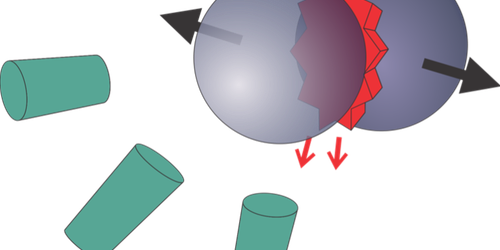Bringing into Focus the Debris of Heavy-Ion Collisions
High-energy heavy-ion collisions create dense, hot nuclear matter. Researchers have been colliding such ions for 60 years. But issues with pinpointing some experimental parameters make it hard for them to determine some information about the collision debris, leading to “blurred” measurements. Now, Pawel Danielewicz of Michigan State University and Mizuki Kurata-Nishimura of RIKEN Nishina Center, Japan, propose a method for reducing these distortions [1].
In a high-energy heavy-ion-collision experiment, researchers collide two ions and then measure the energies and angles of the resulting particles. From these particles, they can coarsely assess the orientation at which the ions enter a collision. They then calculate averages for the orientations of the produced particles relative to that approximate ion orientation. But these averages come at the expense of resolution and detail: they forsake information on how particles get distributed relative to the precise orientation.
To address this issue, Danielewicz and Kurata-Nishimura turned to a deblurring algorithm that is used in optics experiments to sharpen an image of an object that appears unfocused. Applying that algorithm to data simulations for a recent heavy-ion experiment at the Radioactive Isotope Beam Factory at RIKEN, the duo show that they can reverse the distortion of angular distributions caused by uncertainties in the colliding ions’ orientations.
In simulations, the duo also demonstrate that the optics algorithm can restore “true” angular distributions, relative to some fixed system orientation, in a manner akin to restoring car license plate numbers from blurred speed-camera photos. These corrected distributions provide 3D trajectory information about the system, giving a direct view into the central region of the hot, dense matter created during the collision. Danielewicz and Kurata-Nishimura say that this view could yield improved insights into high-energy collisions.
–Rachel Berkowitz
Rachel Berkowitz is a Corresponding Editor for Physics Magazine based in Vancouver, Canada.
References
- P. Danielewicz and M. Kurata-Nishimura, “Deblurring for nuclei: 3D characteristics of heavy-ion collisions,” Phys. Rev. C 105, 034608 (2022).




